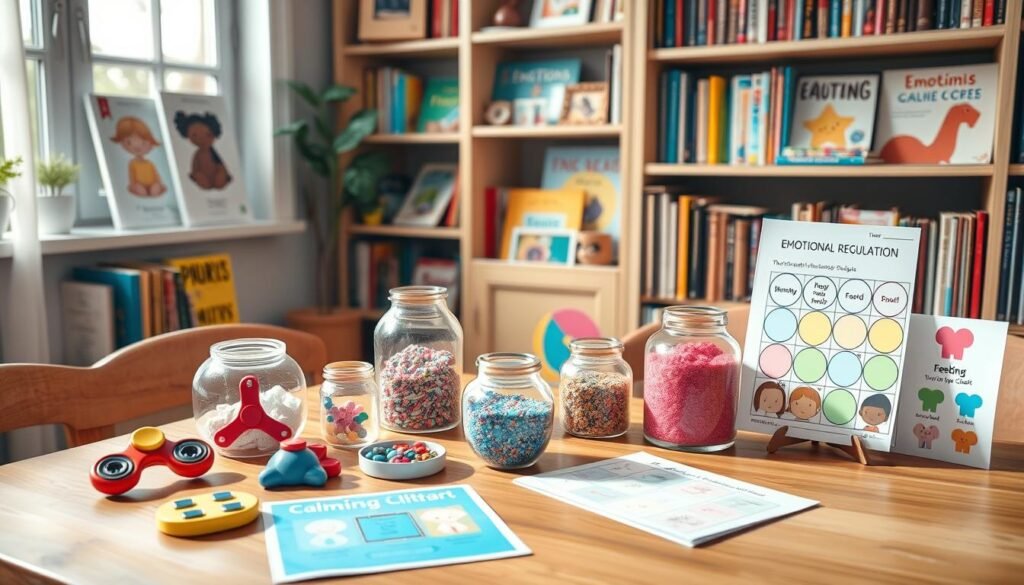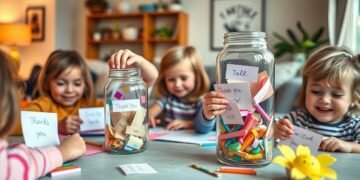Did you know that helping kids manage their feelings can shape their future success? Emotional regulation is a critical skill that impacts both academic performance and social interactions. Teaching children how to handle their emotions early on sets the foundation for lifelong emotional intelligence.
Research from the University of Cambridge shows that physical activity plays a key role in developing self-regulation. This article explores practical strategies parents can use to nurture this skill. From the Begin Approach’s 5 C’s framework to the Zones of Regulation, we’ll cover evidence-based methods that are accessible for various age groups.
Parental modeling also plays a significant role in teaching kids how to manage their emotions. By incorporating these techniques, you can help your child thrive in school, build stronger relationships, and develop resilience. Ready to learn more? Let’s dive into the strategies that make a difference.
Key Takeaways
- Emotional regulation is essential for childhood development and future success.
- Physical activity can enhance self-regulation skills, according to research.
- Practical strategies like the Begin Approach’s 5 C’s framework are effective.
- Parental modeling is crucial in teaching kids how to manage emotions.
- Early development of emotional intelligence offers lifelong benefits.
What is Emotional Regulation and Why is it Important for Kids?
Emotional regulation is a skill that impacts a child’s development. Think of it like adjusting the brightness of a lamp. Sometimes, kids need to dim their overexcitement or boost their low moods to respond appropriately to situations. This ability helps them manage their emotions based on their environment.
From a young age, children start developing the ability to control their feelings. Brain development plays a significant role in this process. The prefrontal cortex, responsible for decision-making and self-control, matures over time. This growth allows kids to better handle their emotions as they grow older.
The Begin Approach’s Character framework emphasizes the importance of emotional regulation. It teaches kids to build resilience and adaptability. Unlike suppressing emotions, regulation involves understanding and managing them effectively. This distinction is crucial for healthy emotional development.
Poor emotional regulation can lead to challenges in school and peer relationships. Kids who struggle may find it harder to focus or resolve conflicts. On the other hand, those who master this skill are better prepared for academic success and social interactions.
Understanding the body-emotion connection is also essential. Physical sensations like a racing heart or tense muscles often accompany strong feelings. Teaching kids to recognize these signs helps them respond more calmly and thoughtfully.
Understanding Emotional Regulation
Emotional regulation is the ability to adjust responses to feelings based on the situation. It’s not about ignoring emotions but managing them effectively. This skill is vital for navigating daily challenges and building strong relationships.
The Role of Emotional Regulation in Child Development
This skill supports brain development, social skills, and academic readiness. Kids who learn to regulate their emotions are more resilient and adaptable. They also tend to have better peer relationships and perform well in school.
How Emotional Regulation Benefits Children’s Well-being
Kids who learn to manage their emotions are better equipped for life’s challenges. This skill not only helps them navigate daily situations but also sets the stage for long-term success. Research shows that emotional regulation is closely tied to self-esteem, social skills, and academic performance.
Building Self-Esteem and Social Skills
When children understand their feelings, they gain confidence in handling difficult situations. This self-awareness boosts their self-esteem. It also helps them build stronger friendships. Kids who can manage their emotions are better at resolving conflicts and empathizing with others.
Studies, like those from Daniel Goleman on emotional intelligence, highlight the importance of these skills. They show that kids with strong social emotional abilities are more likely to form positive peer relationships. This foundation supports their mental health and reduces risks of anxiety or depression.
Improving Academic Performance
Emotional stability plays a key role in learning. Kids who can regulate their emotions are better at focusing and retaining information. This leads to improved classroom performance and higher test scores.
Programs like Begin’s Learn with Sesame Street have shown significant results. They help kids develop these skills early, preparing them for school readiness. Research from the University of Cambridge also links physical activity to better self-regulation, further enhancing academic success.
By teaching kids to manage their emotions, we’re not just helping them in the present. We’re setting them up for a brighter, more successful future.
Key Emotional Regulation Skills Every Child Should Learn
When kids learn to identify their feelings, they gain control over their responses. This skill is essential for navigating daily challenges and building resilience. By teaching children to recognize and name their emotions, you’re helping them develop a foundation for lifelong emotional intelligence.
Identifying and Naming Emotions
One of the first steps in emotional regulation is teaching kids to name what they’re feeling. For example, if a child is scared during a thunderstorm, help them label that emotion as fear. Using tools like an emotion wheel or chart can make this process easier and more engaging.
Mirror exercises are another effective way to teach facial recognition. Have your child look in the mirror and mimic different expressions. This helps them connect physical cues with specific feelings, enhancing their self-awareness.
Recognizing Physical Sensations Linked to Emotions
Emotions often come with physical sensations. Teach your child to notice how their body feels when they’re experiencing strong emotions. For instance, a racing heart might signal excitement or anxiety, while tense muscles could indicate frustration.
Introduce the “body mapping” technique to help them visualize these sensations. Ask questions like, “Where do you feel that emotion in your body?” This practice builds interoception, or the ability to sense internal bodily states, which is crucial for self-regulation.
Grounding techniques, such as progressive muscle relaxation, can also help kids manage overwhelming feelings. These exercises teach them to focus on their body and calm their mind, providing a sense of control during emotional moments.
Emotional Regulation Activities for Children: A Comprehensive Guide
Simple techniques can help kids feel more in control of their emotions. These emotional regulation activities are designed to calm the mind and body while fostering a sense of balance. From breathing exercises to creating a soothing environment, these strategies are practical and easy to implement.
Breathing Exercises to Calm the Mind and Body
One effective method is belly breathing. Teach your child to place one hand on their chest and the other on their stomach. As they inhale deeply, their belly should rise, not their chest. This technique helps slow their heart rate and promotes relaxation.
Another fun activity is bubble breathing. Ask your child to imagine blowing bubbles with their breath. This visualization encourages slow, controlled exhalations, which can reduce stress.
The “flower and candle” breath is also a great tool. Have them pretend to smell a flower (inhale) and blow out a candle (exhale). This simple exercise helps them focus on their breath and calm their mind.
Creating a Calming Space at Home
Designing a calming space can provide a safe retreat for your child. Start with soft lighting, like a dim lamp or string lights. Add cozy textures, such as cushions or blankets, to make the area inviting.
Incorporate soothing sounds, like nature recordings or calming music. Scents can also play a role—essential oils like lavender or chamomile can promote relaxation. For a budget-friendly option, try DIY sensory tents using sheets and fairy lights.
Transition rituals, like spending a few minutes in the space before bedtime, can help your child associate it with calmness. Gradually introduce the area to resistant children by making it a fun and positive experience.
These ideas not only support emotional balance but also create a nurturing environment for growth.
Using Physical Activity to Release Big Emotions
Physical movement can be a powerful tool for managing intense feelings in kids. When children experience big emotions, their bodies often hold onto that energy. Engaging in physical activity helps them release it in a healthy way.
Energy Release Activities for Kids
Simple games can help kids burn off energy and feel calmer. Pillow punching or using stress balls are great for releasing tension. Obstacle courses, both indoor and outdoor, provide a fun way to channel energy.
Family yoga flows are another excellent option. They combine movement with mindfulness, helping kids relax. Movement breaks during homework can also refresh their focus and improve productivity.
The Connection Between Physical Activity and Emotional Regulation
Research from the University of Cambridge highlights the link between movement and self-control. Exercise triggers neurochemical changes, like the release of endorphins, which improve mood. Aerobic activities also activate the prefrontal cortex, enhancing decision-making.
Proprioceptive input, such as jumping or pushing, helps kids feel grounded. This sensory feedback supports emotional balance. Even simple games like “emotion charades” combine movement with emotional awareness, making them both fun and educational.
By incorporating these strategies, you can help your child manage their feelings and thrive in life.
Mood Matching Games to Help Kids Identify Emotions
Games can be a fun and effective way to help kids understand their emotions. By turning learning into play, children can explore their feelings in a safe and engaging environment. Mood matching games, in particular, are designed to help kids recognize and name what they’re experiencing.
How to Play the Mood Matching Game
Start by creating or printing emotion cards with faces showing different expressions. Place them face down and have your child flip two cards at a time. The goal is to find matching pairs. As they play, ask questions like, “What do you think this person is feeling?” This encourages them to think about the emotions behind the expressions.
For a digital twist, use tablets or apps that offer interactive versions of the game. This can make the experience even more engaging for tech-savvy kids. You can also adjust the difficulty by adding more cards or introducing scenarios that explain why someone might feel a certain way.
Role-Playing Emotions Through Games
Role-playing is another great way to explore emotions. Try a game of emotion charades where kids act out different feelings while others guess. This not only helps them recognize emotions but also builds empathy as they consider how others might feel.
You can also create emotion scenario cards. These describe situations like “winning a game” or “losing a toy.” Ask your child how they would feel in each scenario and discuss healthy ways to respond. This connects emotions to real-life experiences, making the learning process more meaningful.
By incorporating these games into your routine, you’re helping your child develop a deeper understanding of their feelings. This skill will serve them well in school, friendships, and beyond.
Mindfulness Practices for Emotional Regulation
Mindfulness can transform how kids handle their daily challenges. By teaching them to focus on the present moment, they learn to manage their feelings more effectively. This practice not only builds calmness but also enhances their ability to think clearly and make better decisions.
Simple Mindfulness Activities for Young Children
Start with the “5 senses” grounding technique. Ask your child to name five things they see, four they hear, three they touch, two they smell, and one they taste. This helps them focus on the present and reduces anxiety.
Mindful eating is another great activity. Encourage your child to eat slowly, noticing the texture, taste, and smell of their food. This practice builds awareness and patience.
Nature observation journals can also foster mindfulness. Have your child spend a few minutes outside, noting what they see, hear, and feel. This connects them to their surroundings and promotes calmness.
The Benefits of Mindfulness in Emotional Regulation
Mindfulness helps kids develop better attention and impulse control. Studies show it can reduce activity in the amygdala, the brain’s stress center, leading to calmer responses to challenges.
It also supports neuroplasticity, the brain’s ability to adapt and grow. Regular practice can improve focus, reduce stress, and enhance emotional balance. Even short sessions, like 30-second meditations, can make a difference.
By incorporating mindfulness into daily routines, you’re helping your child build skills that will benefit them for life.
Reading Books to Teach Emotional Regulation
Books are a powerful tool for teaching kids about feelings and how to handle them. Through stories, children can explore emotions in a safe and relatable way. This method not only builds emotional awareness but also helps them develop empathy and problem-solving skills.
When selecting books, look for titles that focus on social emotional themes. Stories like “Grumpy Monkey” and “The Color Monster” are excellent choices. These books use engaging narratives and vibrant illustrations to help kids identify and understand their emotions.
Recommended Books for Emotional Learning
Some books stand out for their ability to teach emotional skills. “Grumpy Monkey” helps kids recognize that it’s okay to feel grumpy sometimes. “The Color Monster” uses colors to represent different emotions, making it easier for children to name what they’re feeling.
Other great options include “When Sophie Gets Angry – Really, Really Angry” and “The Way I Feel.” These stories provide relatable scenarios that kids can connect with, helping them learn how to manage their emotions in real-life situations.
How Stories Help Children Understand Emotions
Stories allow kids to experience emotions vicariously. By following a character’s journey, they learn how to handle similar feelings in their own lives. This process, known as vicarious learning, is a powerful way to teach emotional regulation.
To make the most of storytime, create discussion guides. Ask questions like, “How do you think the character felt?” or “What would you do in this situation?” This encourages kids to think critically about emotions and their responses.
Voice modulation can also enhance the experience. Use different tones to express emotions in the story. This helps kids connect words with feelings, making the lesson more impactful.
By incorporating these strategies, you can turn reading into a meaningful tool for emotional growth. Whether it’s through a book club or a cozy bedtime story, the lessons learned will stay with your child for life.
Zones of Regulation: A Tool for Emotional Awareness
Using tools like the Zones of Regulation can simplify emotional learning for children. This framework helps kids identify and manage their feelings in a structured way. By categorizing emotions into color-coded zones, it provides a clear system for understanding and responding to different states of mind.
Understanding the Zones of Regulation
The zones are divided into four colors: blue, green, yellow, and red. Each represents a different emotional state. Blue is for low energy feelings like sadness or tiredness. Green is the ideal zone, representing calm and focus. Yellow signals caution, such as frustration or excitement. Red indicates intense emotions like anger or fear.
This system helps kids recognize where they are emotionally and what strategies can bring them back to the green zone. It’s a practical way to teach self-awareness and self-control.
How to Use Zones of Regulation at Home
Implementing the zones regulation framework at home is simple and effective. Start by creating a visual chart with the four zones. Include examples of emotions and calming strategies for each zone. This makes it easy for kids to reference and use.
Here are some practical ideas to get started:
- Create home zone check-in stations where kids can assess their feelings.
- Design personalized zone charts with your child’s favorite colors or characters.
- Develop zone transition strategies, like deep breathing or taking a break.
- Introduce a “zone buddies” system where family members support each other.
- Connect zones to weather metaphors, like “stormy” for red or “sunny” for green.
By incorporating these strategies, you can help your child build emotional awareness and resilience. The zones regulation framework is a powerful tool for fostering healthy emotional development.
Teaching Self-Regulation Through Co-Regulation
Co-regulation is a powerful way to help children build self-regulation skills through connection. It’s a shared process where parents or caregivers provide emotional support to guide a child in managing their feelings. This collaborative approach lays the foundation for kids to eventually regulate their emotions independently.
As Psalm 131:2 suggests, finding calmness often starts with leaning on others. Co-regulation mirrors this idea, offering a safe space for kids to learn and grow. By modeling calm behavior and practicing together, parents can help their child develop resilience and emotional awareness.
What is Co-Regulation?
Co-regulation involves guiding a child through their emotions by offering support and modeling healthy responses. It’s not about solving their problems but helping them navigate their feelings. This process strengthens the parent-child bond while teaching essential regulation skills.
For example, when a child feels overwhelmed, a parent might use the Dragon breaths technique. By breathing deeply together, the child learns to calm their body and mind. This shared experience builds trust and confidence in managing emotions.
Activities for Co-Regulation with Your Child
There are many ways to practice co-regulation at home. Synchronized breathing exercises, like belly breathing or the flower and candle technique, can help both parent and child feel grounded. These activities create a sense of connection and calm.
Joint art projects are another great option. Painting or drawing together allows kids to express their emotions creatively while feeling supported. Partner yoga poses also promote physical closeness and relaxation, making them ideal for self-regulation activities.
Other ideas include creating family mantras, listening to each other’s heartbeats, or using weighted blankets for comfort. These practices not only teach emotional skills but also strengthen the parent-child relationship.
By gradually fading support over time, kids learn to apply these techniques independently. Co-regulation is the first step toward helping your child thrive emotionally.
Helping Children Recognize and Name Their Feelings
Teaching kids to recognize their feelings is a stepping stone to emotional growth. When children can name what they’re experiencing, they gain the tools to manage their responses effectively. This process not only builds self-awareness but also strengthens their ability to navigate challenges.
Strategies for Identifying Emotions
One effective way to help child identify their feelings is through labeling. For example, if a child is scared during a thunderstorm, guide them to name that emotion as fear. This simple act helps them understand and process what they’re feeling.
Another strategy is the body sensation questioning technique. Ask your child, “Where do you feel that emotion in your body?” This encourages them to connect physical sensations, like a racing heart or tense muscles, with specific feelings. Over time, this builds their emotional awareness.
The Importance of Emotional Vocabulary
Expanding a child’s emotional vocabulary is key to their development. When kids have the words to describe their feelings, they can communicate more effectively. This reduces frustration and helps them seek support when needed.
Introduce games like emotion charades or create “feeling of the day” rituals. These activities make learning about feelings fun and engaging. You can also use emojis or emotion charts to help kids visualize and name their emotions.
By focusing on these skills, you’re equipping your child with the tools they need to thrive emotionally. Whether it’s through labeling, questioning, or playful activities, these strategies lay the foundation for lifelong emotional intelligence.
Using Sensory Activities to Calm Big Emotions
Sensory experiences can be a game-changer for managing intense emotions. When kids face big feelings, engaging their senses can help them regain control. These activities provide a tangible way to process emotions and find calmness.
Sensory Tools for Emotional Management
Weighted lap pads are one example of effective tools. They provide deep pressure, which can soothe the nervous system. Lycra swings, like those in success stories, offer vestibular input that helps kids feel grounded.
Texture sorting activities are another great option. By exploring different materials, kids can focus their attention and reduce stress. Olfactory identification games, using scents like lavender or citrus, can also promote relaxation.
How Sensory Input Helps Children Regulate
Sensory input works by engaging the senses to create a calming effect. Activities like tactile exploration bins or cross-modal integration exercises help kids process emotions through physical experiences.
Developing a sensory diet plan tailored to a child’s preferences can make a big difference. Tracking their sensory profile evolution ensures the activities remain effective. These coping strategies not only calm emotions but also build resilience over time.
Building Emotional Regulation Through Daily Routines
Daily habits can shape how kids handle their emotions and build resilience. By weaving emotional awareness into everyday tasks, parents can create a supportive environment for growth. Predictable schedules help children feel secure and in control, which is essential for their development.
Incorporating Emotional Awareness into Everyday Activities
Start with morning check-in rituals. Ask your child how they’re feeling and discuss their plans for the day. This simple practice sets a positive tone and encourages self-reflection.
Mealtime emotion sharing is another effective strategy. Use this time to talk about highs and lows, helping kids identify and process their feelings. Connecting mealtimes to interoception, or the awareness of bodily sensations, can also enhance emotional understanding.
Bedtime reflection practices are equally important. Encourage your child to think about their day and what they’ve learned. This helps them wind down and process their experiences in a calm setting.
Creating Predictable Routines for Emotional Stability
Predictability is key to emotional stability. Introduce “emotion weather” transitions, where kids describe their feelings as weather patterns. This makes emotional awareness fun and relatable.
Car ride conversation starters can also be helpful. Use this time to discuss emotions or practice mindfulness techniques. Gradually increase responsibility by involving kids in planning their routines, which builds confidence and skills.
Track routine consistency metrics to ensure these practices are effective. Over time, these daily routines will become second nature, helping your child thrive in life.
How Parents Can Model Emotional Regulation
Parents play a key role in shaping how their child handles feelings. By demonstrating healthy responses to emotions, they provide a blueprint for their kids to follow. This process, known as modeling, is one of the most effective ways to teach emotional regulation.
For example, when parents manage frustration calmly, kids learn to do the same. Research by John Gottman highlights that children who observe their parents handling emotions well are better equipped to manage their own. This influence extends beyond childhood, shaping how they handle challenges as adults.
Demonstrating Healthy Emotional Responses
One practical way to model emotional regulation is through “think aloud” strategies. When parents verbalize their thought process during stressful moments, kids gain insight into healthy coping mechanisms. For instance, saying, “I’m feeling frustrated, so I’m going to take a deep breath,” teaches kids to pause and reflect.
Another effective method is creating repair rituals. If a parent loses their temper, they can model accountability by apologizing and discussing how they’ll handle the situation differently next time. This teaches kids that mistakes are opportunities for growth.
The Impact of Parental Modeling on Children
Parental modeling goes beyond immediate behavior. It helps break generational patterns of unhealthy emotional responses. By practicing appropriate vulnerability, parents show their kids that it’s okay to express feelings and seek support.
Introducing family emotion meetings can also foster open communication. These gatherings provide a safe space for everyone to share their experiences and learn from one another. Over time, these practices build emotional resilience and strengthen family bonds.
By prioritizing their own self-care, parents set an example of balance and well-being. This not only benefits them but also creates a nurturing environment for their child to thrive.
Resources and Tools for Teaching Emotional Regulation
Equipping kids with the right tools can make managing feelings easier. Parents and educators have access to a variety of resources designed to support emotional growth. From apps to courses, these tools simplify the process of teaching essential skills.
Recommended Programs and Apps
One standout program is Learn with Sesame Street. It uses engaging characters and activities to teach kids about feelings. Another excellent option is the Sensitive & Intense Kids course, which provides strategies for managing strong emotions.
For tech-savvy families, emotion-tracking apps like Mood Meter or Calm can be helpful. These apps guide kids in identifying and understanding their feelings. They also offer practical exercises for managing emotions in real-time.
Additional Resources for Parents and Educators
Free printable repositories, like those from CASEL, offer SEL curriculum materials. These resources are perfect for classrooms or home use. Parent coaching programs, such as those offered by Positive Parenting Solutions, provide personalized support for teaching emotional skills.
Therapeutic board games, like Feelings in a Jar, make learning about emotions fun. Community resources, such as local parenting groups or workshops, also offer valuable support. Research institutions like Yale’s Center for Emotional Intelligence provide evidence-based strategies for educators.
By exploring these tools and resources, parents and educators can create a supportive environment for kids to thrive emotionally.
Conclusion: Helping Your Child Thrive Through Emotional Regulation
Supporting your child in managing their feelings can lead to long-term success in life. By incorporating strategies like breathing exercises, the Zones of Regulation, and parental modeling, you can help them build essential skills progressively.
Patience and persistence are key. Programs like Begin’s Character development offer valuable resources to guide this journey. These tools not only enhance academic and social growth but also foster resilience for future challenges.
Seeking community support can make a significant difference. Whether through local groups or online platforms, connecting with others provides additional insights and encouragement. Remember, these efforts have a lifelong impact, shaping your child’s ability to thrive in all aspects of life.
Take the next step today. Explore Begin’s membership options and discover how you can further support your child’s emotional growth. Together, you can create a foundation for a brighter, more balanced future.
FAQ
What is emotional regulation, and why is it important for kids?
Emotional regulation is the ability to manage and respond to feelings in a healthy way. It’s crucial for kids because it helps them build self-esteem, improve social skills, and handle challenges effectively.
How can breathing exercises help children manage their emotions?
Breathing exercises calm the mind and body by reducing stress and anxiety. They teach kids to pause and focus, making it easier to handle big feelings.
What are some effective physical activities for releasing emotions?
Activities like jumping, running, or dancing help kids release pent-up energy. These movements can reduce stress and improve their ability to process emotions.
How do mood matching games help children identify emotions?
Mood matching games encourage kids to recognize and name their feelings. By matching emotions to scenarios, they learn to understand and express what they’re experiencing.
What are the benefits of mindfulness for emotional regulation?
Mindfulness helps kids stay present and aware of their feelings. Simple practices like deep breathing or focusing on the senses can improve their ability to manage emotions.
How can books teach children about emotional regulation?
Stories with relatable characters help kids understand and process their feelings. Books like *The Color Monster* or *When Sophie Gets Angry* are great tools for emotional learning.
What are the Zones of Regulation, and how can they be used at home?
The Zones of Regulation is a framework that helps kids identify their emotional state using colors. Parents can use it to teach kids strategies for moving from one zone to another, like calming down when upset.
What is co-regulation, and how does it help children?
Co-regulation is when a caregiver helps a child manage their emotions through supportive interactions. It teaches kids how to self-regulate by modeling calm and empathetic responses.
Why is it important for kids to build an emotional vocabulary?
An emotional vocabulary helps kids accurately describe their feelings. This makes it easier for them to communicate and seek support when needed.
How do sensory activities help with emotional regulation?
Sensory tools like fidget toys or weighted blankets provide calming input. These activities help kids focus and feel grounded when overwhelmed.
How can daily routines support emotional regulation?
Predictable routines create a sense of stability and security. Incorporating emotional check-ins or calming activities into daily schedules helps kids manage their feelings better.
How can parents model healthy emotional regulation?
Parents can demonstrate healthy responses by staying calm during stress and openly discussing their feelings. This teaches kids how to handle emotions constructively.
What resources are available for teaching emotional regulation?
Programs like *Zones of Regulation* and apps like *Calm* offer tools for teaching kids emotional skills. Books, online courses, and workshops are also helpful for parents and educators.









